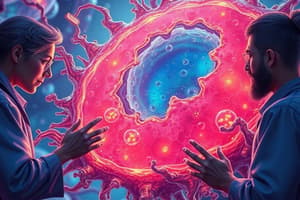Podcast
Questions and Answers
Who is Matthias Jacob Schleiden?
Who is Matthias Jacob Schleiden?
A German botanist who said that the basic cell is the basic unit of plants.
What did Theodore Schwann conclude about cells?
What did Theodore Schwann conclude about cells?
He concluded that both animals and plants are composed of cells.
Robert Hooke coined the term cellula, meaning small rooms.
Robert Hooke coined the term cellula, meaning small rooms.
True (A)
What does the phrase 'Omni cellula e cellula' mean?
What does the phrase 'Omni cellula e cellula' mean?
What is the smallest unit of life?
What is the smallest unit of life?
What is a eukaryotic cell?
What is a eukaryotic cell?
What is the function of the cell membrane?
What is the function of the cell membrane?
What major component is found in the nucleus?
What major component is found in the nucleus?
The ______________ is known as the powerhouse of the cell.
The ______________ is known as the powerhouse of the cell.
Which of the following organelles is involved in protein synthesis?
Which of the following organelles is involved in protein synthesis?
What is the primary role of lysosomes?
What is the primary role of lysosomes?
What is the cytoplasm primarily composed of?
What is the cytoplasm primarily composed of?
Match the following organelles to their functions:
Match the following organelles to their functions:
Prokaryotic cells have a nuclear membrane.
Prokaryotic cells have a nuclear membrane.
Study Notes
Key Figures in Cell Theory
- Matthias Jacob Schleiden: German botanist; proposed that the basic unit of plants is the cell.
- Theodore Schwann: German physician; identified cells as the basic unit of animal life, concluding both plants and animals are composed of cells.
- Robert Hooke: Coined the term 'cellula' meaning "small rooms".
- Rudolf Virchow: Proposed "Omni cellula e cellula" in 1855, stating that all cells arise from existing cells.
Cell Theory Principles
- All organisms consist of one or more cells.
- Cells are the smallest unit of life, with the smallest cell measured at 0.0001 micrometers in bacteria and the largest cell being an ostrich egg measuring 170mm x 120mm.
- All cells arise from the division of pre-existing cells.
Types of Cells
- Eukaryotic Cells: Contain a nucleus and are surrounded by a nuclear membrane; includes animal cells.
- Prokaryotic Cells: Lack a nuclear membrane and nucleus; primarily consist of bacteria and blue algae.
Main Components of Cells
-
Cell Membrane:
- Separates the cell from its external environment.
- Composed of two layers of phospholipids with embedded proteins.
- Functions include selective permeability, endocytosis (phagocytosis, pinocytosis, receptor-mediated endocytosis), exocytosis, compartmentalization, storage, transport, and secretion.
-
Nucleus:
- Functions as the control center regulating RNA synthesis.
- Contains chromatin which consists of coiled DNA bound to proteins (histones).
- Differentiates between euchromatin (active genetic material) and heterochromatin (inactive genetic material, e.g., Barr body).
- Nucleolus is where ribosomal RNA synthesis occurs.
- Nuclear envelope is a double membrane acting as a protein gatekeeper.
-
Cytoplasm:
- Gel-like substance enclosed within the cell membrane, composed of 70-90% water.
- Contains three groups of structures: organelles, cytoplasmic inclusions, and cytoskeleton.
Membrane-Bound Organelles
-
Endoplasmic Reticulum (ER):
- Network of sacs and tubules involved in protein synthesis, packaging, and processing; has rough (with ribosomes for protein synthesis) and smooth (lipid synthesis) types.
-
Mitochondria:
- Site of ATP production through energy transfer from organic compounds; known as the powerhouse of the cell.
-
Golgi Apparatus/Complex:
- Network of membranous vesicles; participates in secretion and polysaccharide synthesis.
-
Lysosomes:
- Main site for intracellular digestion containing hydrolytic enzymes; involved in killing pathogens and degrading waste products.
-
Peroxisomes:
- Also referred to as microbodies; involved in breaking down fatty acids, purines, and toxic compounds.
-
Secretory Vesicles:
- Transport and deliver contents; involved in exocytosis and endocytosis.
Non-Membrane Bound Organelles
-
Ribosomes:
- Can be free or attached to the ER; composed of RNA and proteins; site of protein synthesis.
-
Cytoskeleton:
- A mesh of filamentous elements (microtubules, microfilaments, intermediate filaments) providing shape and enabling cell movement; primarily made of globular protein actin.
-
Microtubules:
- Composes cilia and flagella; long hollow tubes made of tubulin proteins.
-
Cilia and Flagella:
- Assist in cellular movement; cilia are short and numerous, while flagella are longer and fewer.
-
Junctions:
- Points of connection between cells facilitating communication and structural integrity.
Studying That Suits You
Use AI to generate personalized quizzes and flashcards to suit your learning preferences.
Related Documents
Description
This quiz explores the foundational concepts of Cell Theory and highlights the contributions of key figures like Matthias Schleiden, Theodore Schwann, Robert Hooke, and Rudolf Virchow. Test your knowledge on how these scientists shaped our understanding of cells as the basic units of life in both plants and animals.




